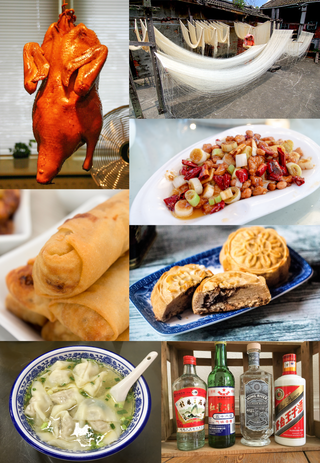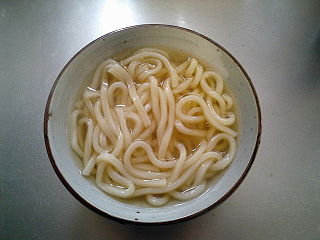| Jilin cuisine | |||||||
|---|---|---|---|---|---|---|---|
| Chinese | 吉林菜 | ||||||
| |||||||
| Part of a series on |
| Chinese cuisine |
|---|
 |
Jilin cuisine is the regional cooking style of the Han Chinese with heavy influence from native Manchu, Korean, and Mongolian minorities in the Jilin Province of Northeastern China.
| Jilin cuisine | |||||||
|---|---|---|---|---|---|---|---|
| Chinese | 吉林菜 | ||||||
| |||||||
| Part of a series on |
| Chinese cuisine |
|---|
 |
Jilin cuisine is the regional cooking style of the Han Chinese with heavy influence from native Manchu, Korean, and Mongolian minorities in the Jilin Province of Northeastern China.
Due to short growing seasons and prolonged winters, fermentation is the main method of preserving food. Suan cai is very prominent in Jilin cuisine. [1] The cold winters have also led to the development of a regional brand to hot pot such as Fucha Manchu Hot Pot. [2] [3] The colder climate of Northern China is generally unsuited to grow rice making wheat, buckwheat, and sorghum as the primary sources of starch. [4] The abundance of starch has given rise to staple steamed buns and noodles dishes of the region. [1] Jilin cuisine in unique among Chinese cuisine by extensive consumption of raw seafood and vegetables. [1]
Jilin cuisine is primarily characterized by influences from the three largest minorities of the province. [2]
The ethnic Han in Jilin cuisine draw influence from Beijing, Shandong, and even Western cuisine. [2] [5] The deep preference and influence of Shandong cuisine come from immigrants who left the province for Jilin during the Qing Dynasty. [2]
Jilin cuisine shares similar dishes with neighboring Heilongjiang and Liaoning provinces being part of the Northeastern Chinese cuisine.
| English | Chinese | Pinyin | Picture | Notes |
|---|---|---|---|---|
| Cold Noodles | 冷面 | lěng miàn | Combination of Han and Korean styles made with sorghum noodles with either sweet/sour or salty flavors. | |
| Steamed White Fish | 清蒸白鱼 | qīngzhēng bái yú | A specific white fish called bái yú from the Songhua River. | |
| Ginseng Chicken | 人参鸡 | rénshēn jī | Small chicken stuffed with rice, ginseng, and red dates, boiled. | |
| Fried Vermicelli | 煎粉 | jiān fěn | ||
| Buckwheat noodles | 饸饹条 | hé le tiáo | ||
| Ula hot pot | 乌拉火锅 | wūlā huǒguō | Ula means river, referring to the Songhua River. | |
| Newly-butchered Pig | 杀猪菜 | shā zhū cài | A banquet where every part of the pig is made into a dish served on the Lunar New Year. | |
| Double Cooked Pork Slices | 锅包肉 | guō bāo ròu | Sweet and sour pork dish originally from Harbin. | |
| Fork fire spoon | 筱筱火 | xiǎo xiǎo huǒ | Buns made with a beef, green onions, fresh ginger, sesame oil filing often stamped with a special iron or "fire fork" to leave the signature of the region. |

Chinese cuisine comprises cuisines originating from China, as well as from Chinese people from other parts of the world. Because of the Chinese diaspora and historical power of the country, Chinese cuisine has profoundly influenced many other cuisines in Asia and beyond, with modifications made to cater to local palates. Chinese food staples such as rice, soy sauce, noodles, tea, chili oil, and tofu, and utensils such as chopsticks and the wok, can now be found worldwide.

Korean cuisine has evolved through centuries of social and political change. Originating from ancient agricultural and nomadic traditions in Korea and southern Manchuria, Korean cuisine reflects a complex interaction of the natural environment and different cultural trends.

Noodles are a type of food made from unleavened dough which is either rolled flat and cut, stretched, or extruded, into long strips or strings. Noodles are a staple food in many cultures and made into a variety of shapes. The most common noodles are those derived from either Chinese cuisine or Italian cuisine.

Udon is a thick noodle made from wheat flour, used in Japanese cuisine. There is a variety of ways it is prepared and served. Its simplest form is in a soup as kake udon with a mild broth called kakejiru made from dashi, soy sauce, and mirin. It is usually topped with thinly chopped scallions. Other common toppings include prawn tempura, kakiage, abura-age, kamaboko, and shichimi spice added to taste.

Chinese noodles vary widely according to the region of production, ingredients, shape or width, and manner of preparation. Noodles were invented in China, and are an essential ingredient and staple in Chinese cuisine. They are an important part of most regional cuisines within China, and other countries with sizable overseas Chinese populations.

Northeast China, also historically called Manchuria or Songliao, is a geographical region of China. It usually corresponds specifically to the three provinces east of the Greater Khingan Range, namely Liaoning, Jilin, and Heilongjiang, but historically is meant to also encompass the four easternmost prefectures of Inner Mongolia west of the Greater Khingan. The heartland of the region is the Northeast China Plain, the largest plain in China, with an area of over 350,000 km2 (140,000 sq mi). It is separated from the Russian Far East to the north by the Amur, Argun, and Ussuri Rivers; from Korea to the south by the Yalu and Tumen Rivers; and from Inner Mongolia to the west by the Greater Khingan and parts of the Xiliao River.

Northeastern Chinese cuisine is a style of Chinese cuisine in Northeast China. While many dishes originated from Shandong cuisine and Manchu cuisine, it is also influenced by the cuisines of Russia, Beijing, Mongolia, and North Korea. It partially relies on preserved foods and large portions due to the region's harsh winters and relatively short growing seasons.

Korean royal court cuisine was the style of cookery within Korean cuisine traditionally consumed at the court of the Joseon Dynasty, which ruled Korea from 1392 to 1910. There has been a revival of this cookery style in the 21st century. It is said that twelve dishes should be served along with rice and soup, with most dishes served in bangjja (bronzeware).

Cellophane noodles, or fensi, sometimes called glass noodles, are a type of transparent noodle made from starch and water. A stabilizer such as chitosan may also be used.

Yunnan cuisine, alternatively known as Dian cuisine, is an amalgam of the cuisines of the Han Chinese and other ethnic minority groups in Yunnan Province in southwestern China. As the province with the largest number of ethnic minority groups, Yunnan cuisine is vastly varied, and it is difficult to make generalisations. Many Yunnan dishes are quite spicy, and mushrooms are featured prominently. Flowers, ferns, algae and insects may also be eaten. The cuisine of Yunnan is often compared to the cuisine of Southeast Asia as the province borders the region and many of the ethnic minorities or related cultural groups also have a presence in Southeast Asia.

Japchae is a savory and slightly sweet dish of stir-fried glass noodles and vegetables that is popular in Korean cuisine. Japchae is typically prepared with dangmyeon, a type of cellophane noodles made from sweet potato starch; the noodles are mixed with assorted vegetables, meat, and mushrooms, and seasoned with soy sauce and sesame oil.

Korean Chinese cuisine, also known as Sino–Korean cuisine, is a hybrid cuisine developed by the ethnic Chinese in Korea.

Indian Chinese cuisine, Chinese Indian cuisine, Sino-Indian cuisine, Chindian cuisine, Hakka Chinese or Desi-Chinese cuisine is a distinct style of Chinese cuisine adapted to Indian tastes, combining Chinese foods with Indian flavours and spices. Though Asian cuisines have mixed throughout history throughout Asia, the most popular origin story of the fusion food resides with Chinese labourers of Calcutta, who immigrated to British Raj India looking for work. Opening restaurant businesses in the area, these early Chinese food sellers adapted their culinary styles to suit Indian tastes.

Korean noodles are noodles or noodle dishes in Korean cuisine, and are collectively referred to as guksu in native Korean or myeon in hanja character. Preparations with noodles are relatively simple and dates back to around 6000 BCE to 5000 BCE in Asia. In Korea, traditional noodle dishes are onmyeon, called guksu jangguk, naengmyeon, bibim guksu, kalguksu, kongguksu among others. In royal court, baekmyeon consisting of buckwheat noodles and pheasant broth, was regarded as the top quality noodle dish. Naengmyeon, with a cold soup mixed with dongchimi and beef brisk broth, was eaten in court during summer.
Korean regional cuisines are characterized by local specialties and distinctive styles within Korean cuisine. The divisions reflected historical boundaries of the provinces where these food and culinary traditions were preserved until modern times.

Manchu cuisine or Manchurian cuisine is the cuisine of Manchuria and Russian Manchuria. It uses the traditional Manchu staple foods of millet, soybean, peas, corn and broomcorn. It relies heavily on preserved foods due to the harsh winters and scorching summers in Northeast China. Manchu cuisine is also known for grilling, wild meat, strong flavours and the wide use of soy sauce. Manchu cuisine is more wheat based than Han Chinese cuisines.

Chinese regional cuisines are amongst the many different cuisines found in different provinces and prefectures of China as well as from larger overseas Chinese communities.

Gansu cuisine, also known as Long cuisine (陇菜), is the regional cooking style of the Han Chinese deeply influenced by the local Hui people in the Gansu province of Northwestern China.